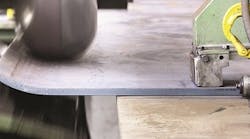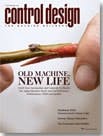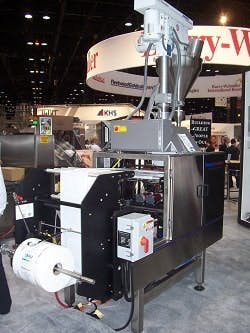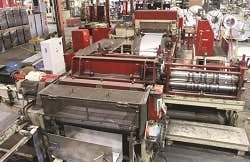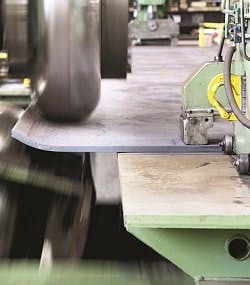Just as getting up, moving around, and sensible weightlifting can get people's blood moving and fuel well-being and happiness, there are more tools and methods that can do the same for supporting and reviving old components, equipment, applications and facilities.
SEE ALSO: Retro Fits: Older Machines, Younger Control Systems
Jim Montague is the executive editor for Control. Email him at [email protected].
Unlike people, the main advantage of renovating and upgrading machines is that far more of their guts and intelligence can be removed, and replaced with new and more capable components. The trick is picking the right ones, and applying them thoroughly and consistently. Luckily, some machine builders have been supporting and refurbishing machines for a long time, and they say many once-difficult renovation jobs are a lot easier now.
"We've always supported our machines cradle-to-grave, and so we often work with equipment that's 35 years old," says Mike Willworth, product support manager at HayssenSandiacre in Duncan, S.C. "For instance, we began making our Ultima 1 and 2 vertical form fill and seal (VFFS) machines with Deca controls about 30 years ago, added continuous motion belts (CMB) in 1990, and we still have proprietary boards for them. We might run out one day, but we've haven't turned anyone away yet."
- When to Upgrade Legacy Machines, and How to Make It Workable
Willworth adds that HayssenSandiacre's technicians are experienced with its older machines and their proprietary controls. It also runs classes on operating and maintaining them, using their original verbiage and nomenclature. However, some veteran machines need even more help. "We recently ran across a 1992 Ultima CMB with a Mateer Burt auger and our Micrologic control," Willworth explains. "It had been traded in several years ago, and was in a warehouse. It had been bought as core salvage, and we were asked to see if we could refurbish it for resale."
Reasons for Revival
While there are many motivations for supporting legacy machines and production lines, the primary yardstick is that rebuilds and upgrades can cost less than buying new equipment — and many builders report old devices still can do their jobs as well or better with a little timely assistance.
"Today's economy forced many manufacturers and retailers to forego complete replacement of aging material handling systems," says Dennis Gates, senior vice president of customer service and support at Intelligrated, Cincinnati, which builds material handling systems, and announced its Lifecycle Support Team at the ProMat tradeshow this year. "The team is dedicated to helping companies give new life to their original system investment by reducing the risk of unplanned downtime, and increasing system utilization through proactive system rejuvenation and maintenance support." The team's lifecycle system support services include audits, control system upgrades and modifications, equipment rebuilds and refurbishments, spare parts supply, warranty administration, obsolescence planning, outsourced maintenance, technical support contracts, repair contract and training.
"The field service and upgrade markets are expanding exponentially because only about 25% of end users are able to do regular machine replacements," says Mark Lewis, technical services group manager at Beckhoff Automation. "Most small shops just can't afford scheduled replacements, and that's why 75-85% of machines operating 20 years ago are still in use now. Users want to do the tasks they've always done, but continue to maximize performance, and make the plant floor more transparent to the rest of the business. So, how can you take equipment that's been in place and running Profibus or DeviceNet since the 1990s, bring it up to modern standards, and have it interact with a manufacturing execution system (MES) at the enterprise level? Every five or 10 years, users seem to run into a maximum production efficiency barrier, and need to make new components mesh with existing machines to achieve further gains, but they need a primary communication backbone between them."
From the Frame Up
Back at HayssenSandiacre, Willworth and his colleagues removed the old Micrologic controls, cabinet, transmission and clutch brakes; further stripped the old Ultima machine to its frame, cross members and castings; cleaned and reanodized them; installed a new cabinet with a new PLC; and upgraded to a 1.8° stepper motor in about three days (Figure 1). Previously, up to about 13 years ago, HayssenSandiacre used its proprietary Micrologic and Macrologic controls, but a couple of years before that it also started using Allen-Bradley SLC 500s, and two years ago it moved to CompactLogix PLCs from Rockwell Automation.
"This kind of renovation gives us a lot more room in the cabinet and inside the rest of the machine," Willworth adds. "And, the new transmission and controls give us better performance when we run film for the bags. We used to get about ± 1/8-inch accuracy, but it could float, and the cutoff might impinge on a bag's graphics. With the stepper motor, we get ±3-5 mm and 50% better accuracy, and we can add servo motors for even more precision. It's still about 18-22% cheaper to remanufacture a machine in this way than it is to build a new one. We can do it for many customers' machines, and then send it back to them."
Besides exchanging controls and adding software, upgrading motors and drives is one of the most popular routes for breathing new life and capabilities into old machines.
SEE ALSO: Rebuild or Buy New?
For instance, Royal Vendors in Kearneysville, W.V., builds and rebuilds cold drink vending machines, and depends on its two-axis forming machine to roll, stamp and cut metal slices for 500 different parts from 3-ft-wide rolls of sheet metal. The 35x75-ft metal former's first axis is a leveler that feeds sheets from 8 to 10 ton rolls into its second axis, which is a straightener that uses an encoder and two photoeyes to feed the metal at preset distances before cutting (Figure 2). However, after more than 30 years its aging DC motors and outdated analog controls weren't delivering the accuracy needed for new, more complex parts; the two axes required two separate inputs, which cut efficiency and used too much power; replacement parts were hard to find; and so Royal faced a classic refurbish or replace dilemma.
"Our studies showed a drive and control systems overhaul was the most cost-effective option," says Scott VanMetre, Royal's plant engineer. "Plus, there were the issues of minimizing downtime and disruption involved in replacing the machine." Consequently, Royal Vendors sought help from distributor Livingston & Haven (L&H) and Bosch Rexroth, and they jointly developed a retrofit plan for the two weeks the former could be down.
"You could say the body was still strong and powerful, but the forming machine needed a new brain and nervous system," says John Gaddum, L&H's automation and regional automation sales manager.
The plan called for replacing the old dc motors and controls with Rexroth's servo drives and air-cooled ac motors with high-resolution encoders. Also, the metal former's interface was set up with an HMI and sercos III protocol. These new digital controls, asynchronous motors, lower-voltage 24 V motor signaling instead of 110 V, and intuitive interface gave the metal former a bunch of improved capabilities. For example, operators now can start roll feed from one HMI input; computerized commands make dimensions for forming and other parameter changes easier; the drive saves space and uses less power; and it works with the asynchronous motors' regenerative functions to reuse previously wasted electricity and reduce energy costs.
Finally, the machine's new controls, drives, motors, HMI and programming make it much easier to adjust, troubleshoot and maintain. "We're changing software commands instead of having to move physical parts and wires," VanMetre says. "It's equally easy to change from one type of job to another."
Likewise, Matrix Packaging Machinery in Saukville, Wis., recently had to upgrade to an alternative ac drive/frequency inverter when the series powering its VFFS machine was about to be discontinued. Matrix uses quick-response ac drives instead of servos to drive two pull-belt gear motors connected to one variable-frequency drive (VFD), which feed correct lengths of packaging film into the sealing operation every few milliseconds.
"We don't have a particularly complicated application," says Mike Krummey, Matrix's controls engineer. "I have two gear motors, 1/3 to 1/2 hp, pulling my film. I have an encoder reading the linear distance. When I get relatively close to my bag length, I need to slow these motors to get the exact bag length. You'd be amazed at the number of drives out there that can't do that."
After a year of searching, Krummey finally found an ac drive from distributor Braas and Omron Electronics that was able to pull the right amount of film and slow/stop correctly during each cycle. This enabled Matrix to keep on building its simple, intermittent VFFS machines, and maintain its competitive price by avoiding servos, but still achieve the same results with its new quick-response drive. "The drive was able to pull 10-in. bags at our rated speed for 6-in. bags, effectively increasing our bags-per-minute capability," says Krummey. "I'd never seen performance this good. It was like this thing was pulling with a servo."
PC-Based Makeover
Another of the primary forces aiding machine upgrades is software. While new hardware gets most of the credit for replacing old hardware, it's really the growing use of software, firmware and microprocessors inside PCs and other components that allows them to be easily reconfigured for many functions — and quickly assist legacy support and upgrade efforts.
For example, Octant Siebdruck in Bielefeld, Germany, recently converted its screen-printing and UV-flash-drying line from PLCs and parallel hardwiring installed in the 1990s to PC-based controls with Ethernet networking. Previously, despite preventive maintenance, the line's performance continued to deteriorate. However, Octant had only three weeks during its customers' holidays to complete its planned migration, and so it sought help from Beckhoff Germany's Applications Engineering department.
SEE ALSO: Time to Make a Change
Originally, the operating panels at each of the line's four printing stations consisted of a self-contained control environment with dedicated I/O components. Octant and Beckhoff replaced this proprietary signal transmission arrangement in the control cabinet with an industrial PC (IPC) and TwinCat NC PTP software, which act as the central controller. A 15-inch, economy control panel is fitted into the front for central, visual component tracking.
In addition, in each printing unit, an EtherCat coupler acts as a decentralized I/O station, which combines all the signals that were originally wired in parallel. Starting from the control cabinet, this EtherCat line stretches out over the field level to the servo controllers. Also, the assemblies of the central chain drive and the individual printing units were replaced with synchronous servomotors and EtherCat servo drives. Only the UV dryer and some sensors were not a part of the upgrade, which was completed within its three-week budget window.
"The equipment is running much more steadily and smoothly," says Stefanie Neuhaus, Octant's managing partner. "Not only is it easier to operate, but the new drive equipment has markedly lowered the level of noise in the production department. Also, during the supervised production startup, plain-text fault messages were made to be more precise, and menu control was adjusted, so the plant now operates more intuitively. Because this has shortened operators' reaction times, our productivity has risen and the amount of scrap has fallen."
As a result, Eisenbau partnered with system integrator and distributor Universelle-Industrie-Automatisierungs, and they decided to migrate the bending machine to positioning with absolute-value encoders. However, the machine's original builder hadn't released all of its technical documentation, so the retrofitters could only use the actual bending formula in C++ language. They managed to integrate this program into the machine's position controls by having it run as part of the PLC program on the software controller on a Simatic Box PC from Siemens Industry.
"The IPC provides the necessary CPU power and enough memory capacity for all the different positioning programs," says Axel Schumacher, Unia's CEO. "In addition, a PCI card with a CP5613 microprocessor enables direct and synchronous connection of the bending machine's ET 200 distributed I/O system to the IPC via Profibus for transmitting its sensor signals and controlling its hydraulic drives."
Besides integrating the bending program into its new controls, the machine increased productivity by shifting its axes faster, optimizing its process controls, saving settings, and continuing to optimize its positioning programs, which include 10,000 versions so far.
On the networking side, Beckhoff's Mark Lewis adds that EtherCat protocol's master cards can feed existing fieldbuses on legacy machines by taking data from their I/O points, encapsulating it in EtherCat packets, and sending it up to PCs on the supervisory side, which can extract and use the original I/O data, but keep this Ethernet-based transfer process transparent to both the machine and its user. He adds that software standards for programming machines, such as IEC 61131, help this transparency by requiring PLCs, I/O modules and other hardware to respond in the same way if they're commanded in the same way, regardless of the source. This means I/O data be brought in, transposed in an IEC 61131 environment, and duplicate a legacy machine's behavior and performance.
"In the past, machine and controls upgrades usually had to be the whole enchilada, and you had to rewire the whole machine and all its software," Lewis says. "Now, these tools allow users to just upgrade the part of the enchilada that they need. So, a user can come in with EtherCat, make a small DeviceNet drop and/or a small Profibus drop, and send it all back to the enterprise via EtherCat to help users make better decisions."
Reviving the Line
Of course, why stop at renovating one machine, when what you really need is upgrading an entire production line or plant?
DuPont's Maydown Kevlar plant in Londonderry, Northern Ireland, recently found it had to quickly upgrade its production line to meet increasing global demand. However, the renovation had to make sure the line would perform the same tasks as before, maintain its tightly controlled output, and cause as little disruption as possible to other processes. Two more challenges included a lack of documentation about programming the original line, and the new production system had to interface with several existing systems, including some customized to DuPont.
The original design work for the migration and upgrade project was undertaken by Day & Zimmermann Ltd., and Rockwell Automation was enlisted to replace old PLCs with ControlLogix PLCs, using ControlNet to communicate with remote I/O racks and thousands of I/O devices. The new PLCs used newly created code based on Maydown's original ladder diagrams to control the third-party, variable-speed drives (VSD), which in turn drive all the axes within the radial spinning process used to make the Kevlar. The PLCs also talk to higher-level distributed control and shop floors management systems. Also, Ethernet communicates with the plant's local area network (LAN); Profibus communicates between third-party devices and PLCs; and Modbus and Modbus+ interface with other systems.
"The engineers had to develop a system that interfaced with both old and new hardware because the migration took place over quite a long timescale," says John Friel, control systems and technical leader on DuPont's PLC migration project. "However, individual machine changeovers were halved during the project due to continual development and refinement of changeover procedures, coupled with faster commissioning and testing periods."
